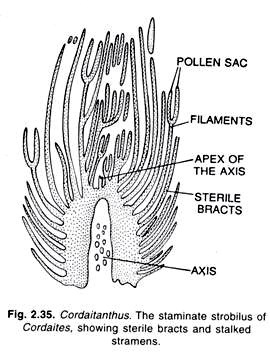ADVERTISEMENTS:
Modifications of Roots for Physiological and Mechanical Functions!
(A) Modifications to Carry on Special Physiological Functions:
1. Storage Roots:
Storage roots become fleshy by the accumulation of stored up food. Very often the aerial parts of these plants die out during unfavourable seasons and, when the season becomes favourable again, new buds sprout either from the underground fleshy root itself or from a small bit of stem above.
Thus, they serve for perennation almost as well as the underground stems. In other cases, especially in the tropics, the reserve food is utilised by the plant during flowering and fruiting. These swollen roots serve as important vegetables and food reserve for the human race.
ADVERTISEMENTS:
This swelling and storage may involve the taproot (with or without its branches) or adventitious roots. Many common vegetables are instances of storage in taproots. Such swollen taproots are named according to the shape assumed.
It is fusiform (swollen in the middle and gradually tapering towards both ends) in radish (Raphanus sativus ), conical (broadest on top and gradually tapering towards the lower end) in carrot (Daucus carota) and napiform (very much swollen above, abruptly tapering towards the lower end) in turnip (brassica campestris var.rapa ) or beet (Beta vulgaris).
It should be noted in this connection that I he underground swollen part of these vegetables is not usually formed by the root alone but the hypocotyl (in radish and turnip the top part is hypocotyl, in carrot the hypocotyl part is negligible) is also incorporated within it.
ADVERTISEMENTS:
It should also be remembered that the terminologies are for particular shapes only and this is not always uniform. Thus, one must not take it for granted that every carrot in the market is conical.
Similar swellings are found in the adventitious routs of many plants. In sweet potato (Ipomoea batatas ) adventitious roots grow from the nodes of the running stem. These become swollen and form the edible root-tubers. Sweet potato tubers do even give rise to adventitious buds but should be distinguished from the ordinary potato which is a stem-tuber.
Tuberous roots are to be found in many common plants like Dahlia, Tapioca (Manihot esculenta), Ruellia tuberosa, etc., and may involve both adventitious and taproots. In some Dahlias, Asparagus, etc., the adventitious roots occur in clusters and all these are swollen. These are called fasciculated roots. An interesting tuberous root is that of some orchids.
In Orchis there is a pair of succulent tuberous roots one of which perishes every year while another new one is formed by its side. Such orchid roots may sometimes be of a palmate shape when they may be described as palmate tuberous.
In the mango-ginger (Curcuma amada ) and in Costus speciosus, only the apices of the adventitious roots become swollen like single beads. This condition is termed as nodulose. In Dioscorea alata, many grasses and sedges and in some Vitis, some roots are alternately swollen and constricted presenting a beaded (moniliform) appearance.
In the valuable medicinal plant ipecac— Cephaelis (= Psychotna) ipecacuanha yielding emetine and now planted on the Himalayas, the roots look as if formed by a number of discs placed one above another. This is described as annulated.
2. Epiphytic or Aerial Absorbing Roots:
Epiphytic or Aerial absorbing roots are the peculiar common roots seen hanging from the orchids . Epiphytes are provided with these aerial roots in addition to the clinging roots .
ADVERTISEMENTS:
The aerial roots are greenish and covered with a spongy velamen tissue with which they absorb atmospheric moisture. Their function is, therefore, absorptive. They also carry on a little carbon assimilation because of the chlorophyll. Such roots are also found in some aroids.
3. Assimilatory Roots:
Assimilatory roots are green while ordinary roots are not so. In some trees, when surface roots get exposed, they turn green by the development of chlorophyll and carry on some carbon assimilation. Epiphytic roots also are assimilatory.
ADVERTISEMENTS:
But, certain plants like Tinospora cordifolia (Menispermaceae) have long green aerial roots whose main function is carbon assimilation. The peculiar family of plants, Podostemaceae , which is quite common in places like Cherrapunji, grows in shallow water on the hills.
The roots cannot penetrate rocks and are exposed. They are green and assimilatory as well as shoot-forming. These roots often assume a flattened thalloid structure and remain fixed on the rock by means of holdfasts called haptera resembling some algae.
4. Reproductive Roots:
Adventitious buds sometimes grow on roots and serve as means of reproduction. Plantlings arise from the base of many garden plants in this way. Root cuttings are the main mode of reproduction in Trichosanthes dioica, sweet potato and ipecac. Podostemaceae propagates through roots. Such roots are, therefore, reproductive.
5. Respiratory Roots or Pneumatophores:
The roots of some trees and shrubs growing in saline marshes (mangrove plants) suffer from the lack of oxygen. To cope with this situation some root branches grow vertically up (i.e., negatively geotropic) into the air from the horizontal secondary roots. Atmospheric air enters these roots through the minute pores of special lenticels (pneumathodes) on the exposed root tips.
ADVERTISEMENTS:
They are, therefore, respiratory roots. Common examples of plants showing respiratory roots are Heritiera (Bengali—sundri which has given the name to the Sunderbans), Rhizophora, etc.
6. Sucking Roots or Haustoria:
These are the sucking roots of parasites discussed . The parasites penetrate the small adventitious rootlets into the tissues of the host so that there is connection between the conducting systems of the two plants .
This is the channel through which food is sucked in by the parasite from
the host. Such sucking roots or haustoria are found in many total and partial parasites .
7. Mycorrhizal Roots:
These are the roots of the mycorrhizal saprophytes, discussed . They usually grow in humus and roots are infested with some fungal mycelia. The mycelia form a mantle on the root which absorbs food solutions (mostly organic) utilised both by the host plant and the mycorrhizal fungus.
The growth of this beneficial fungus on the root atrophies the root which becomes somewhat stunted and often looks abnormal . The tips do not grow and root-hairs are not formed. Such mycorrhizal roots are to be found in trees like pine and birch and in saprophytes like Monotropa, etc. .
(B) Modifications to Carry on Special Mechanical Functions:
1. Prop Roots:
In some tropical trees like Ficus bengahtensis (banyan), the horizontal aerial branches give rise to aerial roots which are provided with root-caps and hang vertically down from the boughs like so many strings. These grow down and, on reaching the soil and becoming anchored, they begin to stouten and ultimately become almost as strong as the main trunk. They support or prop up the horizontal branches like so many pillars .
Ultimately, the main trunk may die when the prop roots fully replace it. Long living banyan trees cover large areas by’ their spreading branches supported on prop roots.
The banyan tree at the Indian Botanical Garden, Shibpur, Calcutta is about 200 years old, covers a large area and has produced more than 900 prop roots. A similar tree in the Theosophical Society compound Adyar, Madras and another in the Buitenzorg Botanical Garden, Java, are equally remarkable.
2. Stilt Roots:
ADVERTISEMENTS:
Certain shrubs and small trees like screw-pine (Pandanus foetidus ) grow on the edges of tanks, marshes, etc., where the anchorage is not very strong. In these cases, short roots grow obliquely downwards from near the base of the stem and act like stilts providing additional support as well as anchorage to the stem.
The adventitious roots growing from the lower nodes of maize plants act in a similar way. Such stilt roots are also seen in mangrove plants like Rhizophora.
3. Root Buttresses:
In some large trees, instead of stilt roots, there are great plank-like roots radiating from the base of the tree like wings . These are called buttresses and are actually partly root and partly stem. They may be seen in old trees of Bombax ceiba, Terminalia catappa, Ficus sp., etc.
4. Climbing Roots:
Some climbers can climb up their supports as adventitious roots growing from the nodes of the frail climber twine round and clasp the support as if the climber has been tied to the support at those points. Common examples are to be found in the aroid Scindapsus officinalis , the betel vine etc.
5. Clinging Roots:
Epiphytes like orchids cling to their support by means of special clinging roots which enter the crevices of the support and fix the epiphyte . Clinging roots may carry on some absorption but are different from the specialised aerial absorbing roots.
6. Haptera or Holdfasts:
The thalloid branching root of Podostemaceae , which is their main plant body carrying on assimilation as well as reproduction, is stuck up to the rock by means of special root processes which may be called holdfasts or haptera as in some algae.
The adhesive discs of adhesive climbers like Ficus repens and Ivy described on page 60 are also types of holdfasts.
N.B:
It may be noted that all the three types of roots, climbing, clinging and holdfasts, may behave in the same way by becoming flattened and disc-like and sticking to their supports or to the substratum.
7. Contractile or Pull Roots:
In plants with underground stems (rhizome, bulb, tuber, corm), there are certain roots which are different from the others as they are found to contract or swell so that the aerial shoot or the underground parts arc kept at a proper level in the soil.
These roots are, therefore, called pull or contractile roots. Those may be seen in Canna, Crocus, Allium, Lilium, etc.
8. Floating Roots:
Certain aquatic floating plants like fussiaea repens (Onagraceae) have special roots growing from the nodes in addition to the ordinary adventitious roots. These roots look like masses of white cotton and are extremely spongy in nature.
Their buoyancy helps to keep the plant floating. If taken out of water they dry and shrivel up quickly. The large amount of air contained in the floating roots may also be of some use in the aeration (‘breathing’) of the submerged organs.
9. Root-Thorns:
In many palms (e.g., Acanthorhiza and Iriartea), some aroids (Pothos armatus) and others, adventitious roots from the base of the stem become hard pointed and thorn-like. These are called root-thorns.
They are of indirect help as an Armature to the plants in driving out marauding animals. Old adventitious roots of coconut, etc., also serve the same purpose.










